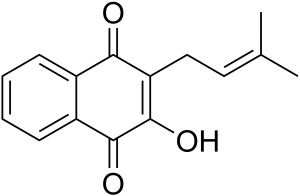It is clear that beta-lapachone, a natural chemical extracted from the bark of the South American lapacho tree, has many beneficial effects for treating tumors, fighting ageing, killing bacteria, viruses, and fungi; and controlling inflammation. Of course, the next question is whether it has any side effects, toxicity, or other harmful effects. One potentially confusing factor when addressing this question is the fact that some studies on beta-lapachone have studied the crude bark extract, often referred to as Pau d’arco extract. Pau d’arco extract contains many different compounds, including one called lapachol. Lapachol has many of the same beneficial effects as beta-lapachone, but it is clear that lapachol can cause severe side effects.
Severe Side Effects of Lapachol
 Pau d’arco extract has been used for centuries as herbal medicine. Researchers intrigued by its apparent anti-tumor activity isolated lapachol back in the 1960s and 1970s, identifying it as the most potent anti-tumor ingredient in the extract. However, it was quickly dropped from research programs after it was noted that it produced severe side effects, such as nausea, vomiting, and anti-vitamin K effects that resulted in failure of blood coagulation (1). In 1994, researchers conducting animal experiments noted that doses of 500 mg/kg of lapachol caused death and severe histopathological changes in the subjects (2). Because beta-lapachone and lapachol are similar molecules with similar modes of action, the concern is that beta-lapachone may also be toxic.
Pau d’arco extract has been used for centuries as herbal medicine. Researchers intrigued by its apparent anti-tumor activity isolated lapachol back in the 1960s and 1970s, identifying it as the most potent anti-tumor ingredient in the extract. However, it was quickly dropped from research programs after it was noted that it produced severe side effects, such as nausea, vomiting, and anti-vitamin K effects that resulted in failure of blood coagulation (1). In 1994, researchers conducting animal experiments noted that doses of 500 mg/kg of lapachol caused death and severe histopathological changes in the subjects (2). Because beta-lapachone and lapachol are similar molecules with similar modes of action, the concern is that beta-lapachone may also be toxic.
Studies on the Toxicity of Beta-Lapachone
The same researchers mentioned above were also able to induce severe side effects and death in animals fed beta-lapachone at 9 mg/kg per day for about a week (the human equivalent dose would be 2.7 grams per day). The animals suffered anorexia, diarrhea, and weight loss, followed by death (2). In a more recent study conducted on rats, beta-lapachone was found to be teratogenic (caused birth defects) when fed to pregnant rats (3). It was also found to cause some hematological changes, but no toxic effects on the liver or kidneys were identified (3). The study was unable to confirm the anorexia, weight loss, and deaths reported by the 1994 study.
In another study on mice, aged mice were fed beta-lapachone for several months, included at 0.066% in the diet (4). The average C57BL/6j mouse (the strain of mice used in the experiment) weighs around 25 grams and eats around 4.5 grams of food per day (5). Therefore, the mice in the experiment were consuming a daily dose of beta-lapachone of around 120 mg/kg, far higher than the dose used in the 1994 study mentioned above. Not only did these mice not suffer from anorexia or death, they actually experienced dramatically improved health. We can only speculate as to why the 1994 study reported such different results- perhaps their preparation of beta-lapachone was impure, and the impurities were actually the cause of the high observed toxicity.
Pharmaceutical Studies of Beta-Lapachone
In rats fed doses of 40 and 1.5 mg/kg beta-lapachone, the drug was found to be only around 15% bioavailable (6). When administered orally, the compound had a half-life of around 11 hours in the serum, suggesting that even if taken daily, the drug would not be able to accumulate in the body to toxic levels. Mice fed a specially prepared form of beta-lapachone, intended to improve its bioavailability, exhibited an LD50 of 50 to 60 mg/kg (7). The LD50 means the dose at which 50% of the mice die. However, because the drug used in this study was altered to dramatically increase bioavailability, it is difficult to translate its results to a dose of regular beta-lapachone. Studies of beta-lapachone in mice often use doses of regular beta-lapachone of around 50 mg/kg and rarely report any signs of toxicity; most report health benefits. For example, one study of mice reported 40 mg/kg per day for 4 days of beta-lapachone could prevent renal damage due to co-administration of chemotherapeutic agents (8).
The Bottom Line
The vast majority of scientific studies on beta-lapachone have been conducted on cell lines and in other in vitro settings. In these settings, it is clear that higher doses of beta-lapachone have some cytotoxic effects, but these may be entirely due to the the fact that the cell lines being used tend to be derived from cancers, and beta-lapachone is known to be a potent killer of cancer cells. At this point in time, the strongest evidence of a lack of adverse effects and toxicity is the study mentioned above, where mice were fed a fairly high dose of beta-lapachone for several months and experienced improved health, not toxicity (4). Until further experiments have been done, the appropriate human dose of beta-lapachone and its safety cannot be stated with certainty.
References:
(1) www.rain-tree.com/paudarco.htm#.VghMyFUViko
(2) Planta Med. 1994 Aug;60(4):373-4.
(3) Phytother Res. 2009 Sep;23(9):1276-80. doi: 10.1002/ptr.2646.
(4) PLoS One. 2012; 7(10): e47122. doi: 10.1371/journal.pone.0047122
(5) Behav Genet. 2002 Nov; 32(6): 435–443.
(6) Biomol Ther (Seoul). 2015 May; 23(3): 296–300. Published online 2015 May 1. doi: 10.4062/biomolther.2015.029
(7) Pharm Res. 2003 Oct;20(10):1626-33.
(8) Kidney Int. 2014 Mar; 85(3): 547–560. Published online 2013 Sep 11. doi: 10.1038/ki.2013.330

Leave a comment